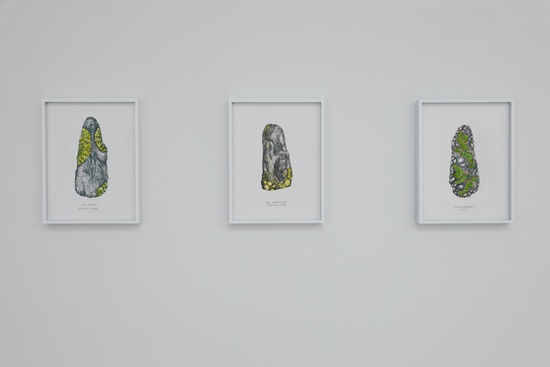Trans Neolithic Future, series of drawings
Jasper Griepink
(2019)
These playful and visually enticing works can be seen as a personal interpretation of the various theories put forwards by archaeologists who propose that early European/Mediterranean societies were ruled by matriarchal systems. Based on the research preceding Griepink’s work commissioned for Orgonomics, Darkness is light germinating (Earth Table 1), these drawings suggest an alternative Neolithic time/space that either has already happened or is perhaps still yet to come.
Within the cosmology of various indigenous people around the globe, the past and the future are considered one-and-the-same; a distant time. Reflecting the impossibility to find remnants of the tender, oratory, empathic and intimate interpersonal realities amongst early age inhabitants of Europe, Griepink suggest we can only focus on creating the reality we choose, today. He states, ‘remnants of deep interrelatedness are harder to find than the solid symbolisms of power, the truth of what we once valued collectively as embodied Earth Oriented Societies can perhaps only be intuited.’
With these drawings, Griepink proposes a Neolithic landscape where gender is experienced as a geography of specific and various zones, rather than a binary construct. Its variety is celebrated at these sacred sites represented in the drawings. “What happened to gender somewhere between the paleolithic and the now? How do various cultures deal with gender, and how has this been transitioning over time since/via colonialism? To process these questions, I present archaeological findings in the form of drawings. Together they propose the remnants of a Utopian Neolithic time where people are predominantly non-binary and trans. It is a vision of the future or perhaps a rewriting of the past. Suspended in the realm of manifestation, I project upon the Granite, Gneiss and Rapakivi stones of the dolmen that stand scattered in the European landscape. Sites for celebration, acknowledgment, process and gathering. These stones are my Sacred Sites.’
In stark contrast to the grey hues of the stones in these works, Griepink chose bright green lichen as the herald of nature’s wild wisdom. A viridescent film sprawling over the voluptuous and monumental stone configurations. We see lichens, a multi-species composed of a fungus living in a symbiotic relationship with an alga or cyanobacterium (or both in some instances). There are about 17,000 species of lichen worldwide and for the artist these represent the potential of cross-species collaboration and the various gender-mixes and forms of life that exist. Additionally, they represent the persistence of nature which will always cover up and layer over whatever humanity has done and will be doing. Emphasizing the pivotal times in our current global ecology, Griepink notes that lichen usually grow in unpopulated natural areas or regions with profoundly clean air. He notes that there has been a rise of Lichen all over the Netherlands; a promise of a recovering atmosphere, or the prelude of a post-human era in which the green has taken over?



